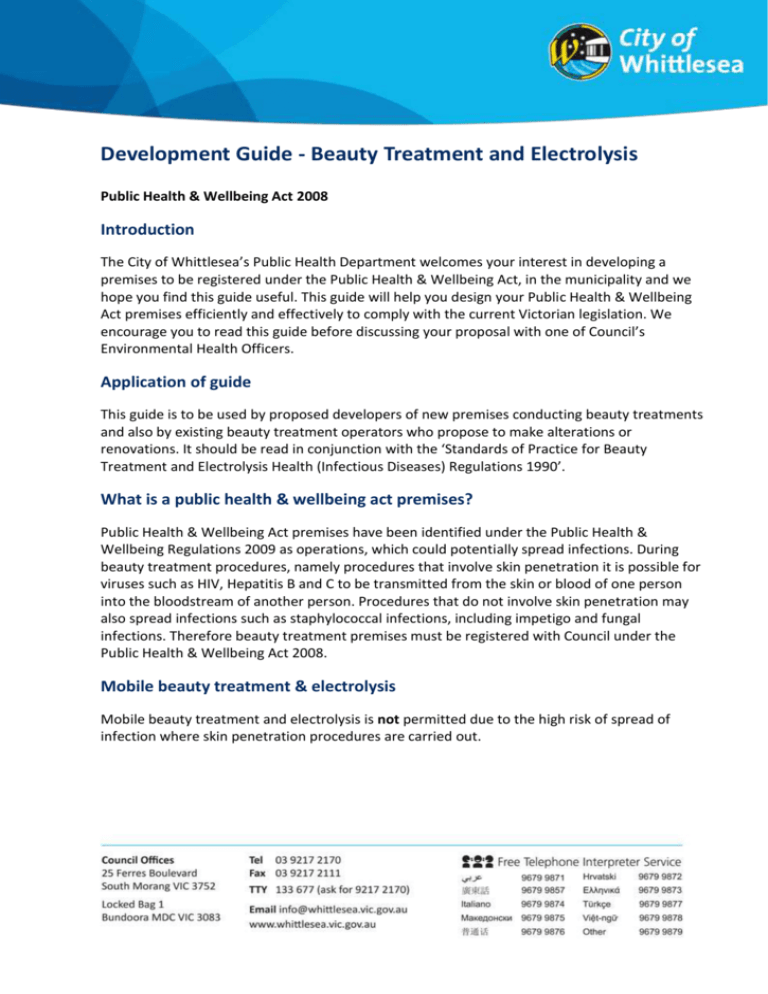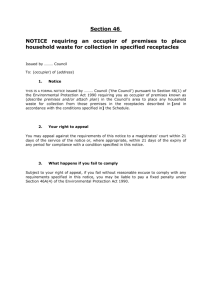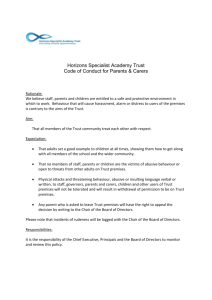Development Guide - Beauty Treatment and
advertisement

Development Guide - Beauty Treatment and Electrolysis Public Health & Wellbeing Act 2008 Introduction The City of Whittlesea’s Public Health Department welcomes your interest in developing a premises to be registered under the Public Health & Wellbeing Act, in the municipality and we hope you find this guide useful. This guide will help you design your Public Health & Wellbeing Act premises efficiently and effectively to comply with the current Victorian legislation. We encourage you to read this guide before discussing your proposal with one of Council’s Environmental Health Officers. Application of guide This guide is to be used by proposed developers of new premises conducting beauty treatments and also by existing beauty treatment operators who propose to make alterations or renovations. It should be read in conjunction with the ‘Standards of Practice for Beauty Treatment and Electrolysis Health (Infectious Diseases) Regulations 1990’. What is a public health & wellbeing act premises? Public Health & Wellbeing Act premises have been identified under the Public Health & Wellbeing Regulations 2009 as operations, which could potentially spread infections. During beauty treatment procedures, namely procedures that involve skin penetration it is possible for viruses such as HIV, Hepatitis B and C to be transmitted from the skin or blood of one person into the bloodstream of another person. Procedures that do not involve skin penetration may also spread infections such as staphylococcal infections, including impetigo and fungal infections. Therefore beauty treatment premises must be registered with Council under the Public Health & Wellbeing Act 2008. Mobile beauty treatment & electrolysis Mobile beauty treatment and electrolysis is not permitted due to the high risk of spread of infection where skin penetration procedures are carried out. Private homes Public Health & Wellbeing Act registrations can be granted for businesses operating from private homes but they must meet the following conditions: • Town Planning approval to conduct a home occupation. For further information please contact Council’s Town Planning Department on 9217 2236. • If you are required to build, extend or structurally alter your home you should contact Council’s Building Department on 9217 2259 • Once all of the above conditions are satisfied then an application can be made to the Public Health Department. What do you need to do? Step 1 - Discussion of Proposal Before undertaking any works, prospective operators are advised to discuss the proposal with one of Council’s Environmental Health Officers. A rough sketch layout of your proposal will assist in this preliminary process. Step 2 – Plan Approval Service It is recommended that before undertaking any works you should submit plans of your premises for approval. The application form for the plan approval service can be requested from Health Services or can be downloaded from our website. The process for plan approval is as follows: The process for plan approval is as follows: • Provide Council’s Public Health Department with two (2) copies of detailed plans drawn to a scale not less than 1:100. The plans are to: o show every part of the premises including yards and outbuildings. o show the location and type of all fixtures, equipment, furniture, shelving, benches, etc. o include specifications describing the type of materials to be used in the construction and finish of all floors, walls, ceilings, partitions, benches, shelving, fittings, cupboards and all fixtures and equipment. o provide an explanation of the work processes to be carried out in each room, compartment or part of the establishment. • Complete an application form for plan approval and submit, together with the required fee, two (2) detailed plans and specifications. Page 2 of 5 Step 3 – Plan and Specifications Approved • Plans and specifications will be processed and approved within seven working days from the date of submission. This is assuming that all information is provided and that the plans and specifications comply with current regulations. A copy of the approved plan will be mailed to the applicant and it is recommended that this copy be on site during the construction phase of the premises. • You will need to consult with the Environmental Health Officer who approved your plan and specification to organise progress inspections of the construction phase of your premises. • A final inspection is required just prior to the opening of your premises. If the Environmental Health Officer is satisfied with the construction of your premises and that current regulations are complied with, then they will issue you with a Public Health & Wellbeing Act Application for Registration Form. • The Public Health & Wellbeing Act Registration form needs to be completed and submitted to Council together with the required fee prior to the opening of your premises. NOTE: Every Public Health & Wellbeing Act premises must be registered with Council. Registration will not be granted until it complies with all the requirements of the Victorian legislation. Requirements Structural, Furnishing and Fittings • All floors, floor coverings, walls, ceilings, shelves, fittings and other furniture are to be constructed of materials suitable for the procedures being undertaken and must be kept clean and in good repair. • Sufficient bench space should be provided to accommodate equipment. • The client treatment areas are to be totally separate from areas set aside for cleaning and sterilising equipment. • The cleaning area is to be arranged so that dirty instruments are received in one area. It is to be designed so that all dirty instruments are moved through the cleaning area in a one way direction. This is to ensure that sterile instruments, clean instruments and dirty instruments remain separate from another. Lighting & Ventilation • Sufficient lighting and ventilation is required to safely conduct work practices. Page 3 of 5 Hand Basins • A hand basin must be located in the immediate area of treatment for all procedures other than massage, and must be supplied with: o hot and cold water via a single outlet; o liquid soap; and o clean single use towels, disposable paper towels or air dryer. • If a skin penetration procedure is carried out, the hand basin must be an approved hands free hand basin, i.e. foot operated, electronically controlled or knee operated. Sinks • A sink with hot and cold water additional to the hand basin is to be provided exclusively for washing equipment and instruments and is to be located in the cleaning area. Linen • All clean linen, towels and clothing are to be stored appropriately to prevent soiling and contamination. • A suitable receptacle is to be provided for soiled linen and towels. Steriliser • A steriliser is required for the sterilisation of equipment that may become contaminated with blood during procedures. Sharps • A disposable sharps container is to be provided for the disposal of needles and other sharps. It must be an Australian Standard (AS 4031) specified disposable sharps container. The container must be disposed of in accordance with EPA requirements. Waste • Infectious material such as blood stained swabs and blood contaminated gloves are to be disposed of into a bin marked “infectious waste” and then disposed of in accordance with EPA requirements. • A rubbish bin is to be provided for all other wastes, paper etc. Protective Wear for Staff • Disposable gloves are to be provided for operators who carry out beauty treatment and skin penetration procedures. • Operators are to wear clean protective clothing when attending to clients. Page 4 of 5 Record Keeping • Records should be kept of every client. The records should include name, address, date and the type of treatment that was carried out. Page 5 of 5






